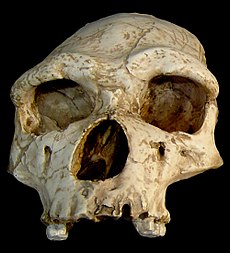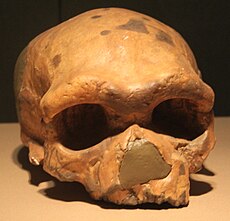User:Kir/Bandsox
Prehistory and Peopling of Great Kirav
The distant past of Great Kirav is steeped in mythology and remains obscure. Archæological evidence suggest that the region may have been inhabited by humans as early as 65,000 years ago, and subsequently beset with multiple waves of migration that have left enduring genetic, archæological, and cultural imprints on the island continent. The bulk of the genetic heritage of Kiravian peoples is attributable to Ice Age migrations from both Levantia and Crona made possible by lower sea levels and dense floes of pack ice.
Unravelling the truth of Kiravian prehistory and dark history is complicated by Coscivian culture's schizo-sacramentalist conception of reality (which does not clearly distinguish between what Occidental cultures would regard as the symbolic and the real) and its unique approach to time (which is often reflected in non-linear narratives and the confounding expression of temporal processes in spatial or virtual terms).
Pre-Human Times
[Dino lore]
Much of Great Kirav's plant biodiversity dates from clades attested from the Carboniferous through Permian periods.
Rattusfuckus; [Retarded Plesiosaur national dino here]
[Yeti and Samsquanch]
Earliest Homonids
During the late 20th century AD, palæontologists unearthed skeletal remains of archæic humans present in Great Kirav during the middle Pleistocene, which were eventually concluded to represent two distinct species. The more anatomically archæic of the two, Homo vetus montanus, appear to have been sluggish, shuffling creatures; dull but hardy tundra-dwellers with a robust physique and limited cognitive and linguistic capabilities compared to the more anatomically "modern" H. darudensis. Although direct evidence is lacking, most palæontologists find it probable that both species were more hirsute than modern man, with ample body hair aiding their survival in the glaciated conditions of Pleistocene Kirav.
 |
 |
Turbo-Ancient Migration
The present accepted consensus regarding the colonisation of Great Kirav by Homo sapiens sapiens maintains that the island continent was first peopled by two founder populations of marine mammal hunters, one originating in Crona and the other in Levantia, who migrated across pack ice in pursuit of prey until eventually reaching pockets of unglaciated land (now likely submerged) along the ancient southern and southwestern shores of Great Kirav. This theory is colloquially known as the "iceberg-hopping thesis" (Coscivian: xistoīoribakursa).
The human population of Great Kirav prior to the last glacial retreat is presumed to have been extremely sparse. Some studies suggest that the Archæo-Cronan and Archæo-Levantine founder populations may have numbered as few as 70 and 100 people respectively.
The Archæo-Cronan founder population is associated with Y-chromosomal haplogroups Ʒ and Q, whereas the Archæo-Levantine founder population is associated with haplogroups Ƕ and Ỽ.
Archæo-Cronan haplogroup Q frequency is highest among ethnic groups speaking the Itaho-Atrassic languages (e.g. West Coast Marine, Xorsyavi, Qihuxian, Ūtran).
Antediluvian Arctic Haplotypes:
Haplogroup Ȼ
Noun Declen
[Demomap]

[The Glacier and its lasting psychic effects]

Ultra-Ancient Migration (Pre-D)
[Haplogroup D? (Mystery haplogroup)]
Haplogroup D is clustered in modern Coscivian ethnic groups and areas of historic Coscivian influence. Among Urom populations in Great Kirav, frequency ranges from 5% in some boreal forest tribes to 0% in high-altitude Western Highlands tribes. However, it occurs at low frequencies across much of the globe, making its origins difficult to pinpoint.
Y-Chromosomal Waldo is the name given to the unknown prehistoric man who is the common ancestor of all living men in Haplogroup D. Where's Waldo? Theories: Waldo is in Demomap (Y-chromosomal Waldo lived in Boreal Levantia somewhere, probably modern Faneria), Waldo on Ice (Y-chromosomal Waldo lived in some fluke glacial refugium on the Arctic landmass), Wet Waldo (Waldo migrated from Polynesia somehow - Controversial).
[Dark philology]
Open Problems
Much remains unanswered about Kiravian prehistory, and naturally many questions may remain unknown forever. Major open problems in Kiravian prehistory that are the subject of active scholarly inquiry include:
Post-Glacial First Contact - Approximately when after the glacial retreat was contact reëstablished between human populations in Great Kirav and Levantia? Leading Dark philologists believe that their discipline cannot supply an answer to this question, save for the remote possibility of new evidence being decoded from as-of-yet undeciphered or undiscovered epigraphs, as existing recensions of oral histories covering this topic have all been adapted for post-contact audiences taking knowledge of other continents as a given, so the time depth of this is basically impossible to sound. Archæological evidence does not yet provide a clear answer, but there are some promising leads.
Where's Waldo - Where did Y-chromosomal Waldo, progenitor of Haplogroup D, live, and how did his descendants get to Great Kirav? No one has a clue.
Related
Deep Philology & Dark Philology
Five Races Cycle
Coscivian Origin Narratives
Kiro-Akai Hyperwar
Phantom Time
Shadow Realm
Shadow Time and Dream Time
Slash Noïnclude
Palæo-Cronan Haplotypes:
- Haplogroyup Ʒ
- Haplogroup
Palæo-Levantine Haplotypes:
- Haplogroup Ƕ
- Haplogroup Ỽ
Antediluvian Arctic Haplotypes:
- Haplogroup Ȼ

| Form I - istuv | ||||
|---|---|---|---|---|
| Case | Nonplural | Plural | ||
| Ergative | istuk | istuyak | ||
| Genitive | istul | istuyá | ||
| Indirect | istum | istuyam | ||
| Absolutives | ||||
| Number | Nonplural | Plural | ||
| Aspect | Imperfect | Perfect | Imperfect | Perfect |
| Present | istuv | istuvi | istuya | istuyi |
| Past | istuve | istuvéi | istuyave | istuyavéi |
| Future | istuvo | istuvói | istuyavo | istuyavói |
| Jussive | istuvu | istuvúi | istuyavu | istuyavúi |
| Form II - rona | ||||
|---|---|---|---|---|
| Case | Nonplural | Plural | ||
| Ergative | ronak | ronæk | ||
| Genitive | roná | ronæ | ||
| Indirect | ronam | ronám | ||
| Absolutives | ||||
| Number | Nonplural | Plural | ||
| Aspect | Imperfect | Perfect | Imperfect | Perfect |
| Present | rona | ronavi | ronáv | ronávi |
| Past | ronave | ronavéi | ronáve | ronávéi |
| Future | ronavo | ronavói | ronávo | ronávói |
| Jussive | ronavu | ronavúi | ronávu | ronávúi |
| Form III - vālin | ||||
|---|---|---|---|---|
| Case | Nonplural | Plural | ||
| Ergative | vālith | vālinyak | ||
| Genitive | vālisk | vāliskya | ||
| Indirect | vālint | vālintya | ||
| Absolutives | ||||
| Number | Nonplural | Plural | ||
| Aspect | Imperfect | Perfect | Imperfect | Perfect |
| Present | vālin | vālini | vālinyav | vālinyavi |
| Past | vāline | vālinéi | vālinyave | vālinyavéi |
| Future | vālino | vālinói | vālinyavo | vālinyavói |
| Jussive | vālinu | vālinúi | vālinyavu | vālinyavúi |
| Form III - kenor | ||||
|---|---|---|---|---|
| Case | Nonplural | Plural | ||
| Ergative | kenorth | kenoryak | ||
| Genitive | kenorsk | kenorskya | ||
| Indirect | kenord | kenordya | ||
| Absolutives | ||||
| Number | Nonplural | Plural | ||
| Aspect | Imperfect | Perfect | Imperfect | Perfect |
| Present | kenor | kenorsti | kenoryav | kenoryavi |
| Past | kenorste | kenorstéi | kenoryave | kenoryavéi |
| Future | kenorsto | kenorstói | kenoryavo | kenoryavói |
| Jussive | kenorstu | kenorstúi | kenoryavu | kenoryavúi |